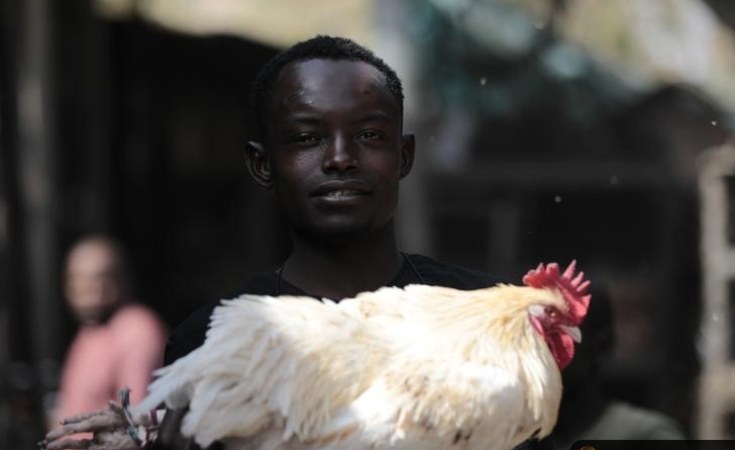Avian influenza is a highly contagious viral infection of birds, commonly called "bird flu", which has been recurring in Nigeria since 2006. It has resulted in the loss of millions of birds and income for people who rely on the poultry industry. Nigeria is currently grappling with another outbreak which started in 2021.
The Conversation Africa asked Clement Meseko, a virologist and expert on animal influenza, to explain the disease's re-occurrences.
What is bird flu? How does it spread? Is it dangerous to humans?
Bird flu is scientifically known as avian influenza and the pathogenic form as highly pathogenic avian influenza. It is a disease in birds (specifically poultry) caused by an influenza virus. It is highly pathogenic, meaning it causes tissue and organ damage in the host, and can kill more than 75% of the infected flock.
Waterfowls like ducks are natural reservoirs of the disease. They can harbour avian flu without showing any symptoms. Many waterfowls and other wild birds are migratory, moving across and between continents - this brings them into contact with resident birds and domestic poultry. Their body secretions and excretions may contain virus that can then infect other birds and poultry.
The symptoms in infected poultry include sudden death, respiratory distress, cough and haemorrhages in tissue and organs. Other animals, including pigs, horses and dogs can also be infected - and so can humans. In fact, it is zoonotic and therefore can be fatal for humans too. Highly pathogenic avian influenza H5N1 virus infections have infected more than 880 people with about 50% case fatality globally.
The virus also has the capacity to cause a pandemic: an influenza virus of avian origin, but not the currently circulating strain, caused the 1918 pandemic that ultimately killed about 50 million people - worse than the current COVID-19 pandemic .
How many outbreaks have there been in Nigeria since 2006?
Nigeria's first outbreak of bird flu was confirmed in January 2006, the first epidemic in poultry in Africa. It killed millions of birds and millions more were culled to contain its spread. The economic and livelihood loss was huge as the disease spread all over the country with 100% mortality in many cases. The estimate of the economic cost of bird flu outbreak in Nigeria was over nine billion Nigerian naira (about US$32 million) - with people losing investment, livelihood and jobs.
The disease was brought under control by 2008 thanks to stringent biosecurity measures like depopulation (culling), decontamination and control of poultry movement. In 2015 another strain emerged in Nigeria. Since then, new strains keep appearing.
Live bird markets, common across Nigeria, are the main points of spread of bird flu while wetlands are the points of initial transmissions. Local waterfowls and other birds that may harbour avian flu come into contact with other bird species and with people. In 2006, 312 cases and in 2015, 256 outbreaks of highly pathogenic avian influenza were recorded.
What should Nigeria be doing differently?
The disease may become endemic in Nigeria if circulation continuous and detection of the same strain is established. If a disease is constantly circulating in reservoir hosts it will lead to spill over to poultry and humans.
If that's the case, biosecurity measures must be stepped up. For instance, the government may consider other measures in addition to biosecurity. This may include controlled and regulated vaccination. There are vaccines. They have been used in Egypt, China, Indonesia with a mixture of failure and success. Vaccines only reduce the impact of the disease but do not prevent infection or re-infection.
Those in the agricultural sector also need to introduce effective control measures at live bird markets and in the way poultry is traded more broadly. Measures would include restructuring the live bird markets, discouraging the mixing of species, the introduction of plastic cages and crates that can be easily cleaned and disinfected. Frequent cleaning, disinfection and decontamination of live bird market environments is very important for disease containment.
You've described as Nigeria was an "ecological sink" for such viruses. Please explain
In the research that examined the outbreak of the 2015-2016 bird flu, we found that west Africa was the epicentre of the virus that was later found in other sub-Saharan African regions - the central, eastern and southern African countries. In particular, within west Africa, Nigeria was the most important point of virus introduction and a central hub in the virus spread.
Bird flu is mostly introduced into Nigeria through the presence and activities of wild birds. For instance, in the 2015-2016 outbreak we identified four virus introductions into Nigeria likely from east Europe.
These birds travel across continents and countries through multiple international migratory routes, in much the same way that airlines move across the world on designated routes. Three major wild bird migratory routes from Asia and Europe transverse Nigeria. That's good news for biodiversity but bad news for disease control.
Bird watchers and ornithologists have found that migratory birds from Europe move into Nigeria every year during the cold harmattan season (November - February). This is the peak time for avian flu outbreaks.
Nigeria is the most affected African country in terms of the frequency and burden of avian flu. This makes it the destination "sink" of the strains that may be circulating in Europe at any given time.
Because we can't change birds' routes or habits, it would be up to Nigerian authorities to make sure it keeps its local birds and people as safe as possible. This would include surveillance of wild birds at wetlands and the monitoring of viral infections. Early detection is vital for early warning, risk analysis and control of infection.
Clement Meseko, Veterinarian & Virologist, National Veterinary Research Institute, Vom, Jos


